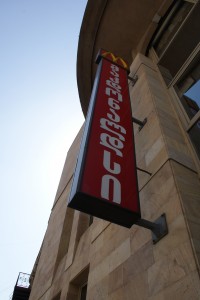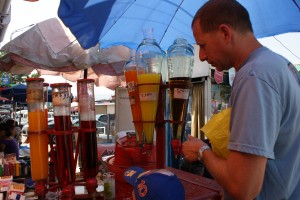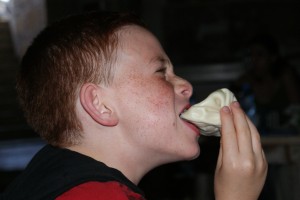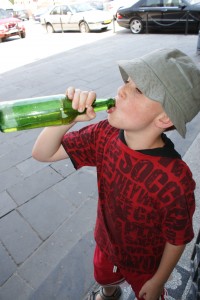From everything that I had read, Georgia was supposed to have fantastic cuisine.
But from the moment we arrived, we struggled to find this. Our food experience in Batumi wasn’t good – near the beach we only found places with menus in Georgian – we had no hope of ordering anything. Away from the beach, we had found a great looking place that had no space, and eventually when we did find a restaurant that was open, the food was inedible. We were saved by the discovery of a Turkish restaurant the following day – Turkish food is invariably good whenever it is authentic.
Arriving in Tbilisi, we were welcomed by Rusiko, at whose apartment we were staying, with a home-made Khachapuri. This is the national snack of Georgia – bread baked with cheese inside. Often translated as a “cheese pie”, khachapuri comes in many different regional styles. Rusiko’s was quite delicious – quite heavy food, it was made with a typical white cheese that is found throughout Georgia. The problem was that the white cheese is salty, and so the kids didn’t like it at all. Another well known version is Adjaran Khachapuri – which I had tried in Batumi. It is cholesterol heaven – a boat shaped pastry, filled with cheese and with a raw egg and at least a quarter pound of butter floating on top. It had been tasty, but I felt so guilty eating it and it was so rich that I simply couldn’t allow myself more than a few bites.
So, within the first two days, it was apparent that health concerns are not top of the agenda in Georgia – smoking in the hotels is allowed, and then the national snack is a cholesterol laden feast.
The food did improve. In Tbilisi we found a chain of Georgian restaurants that was excellent – we tried a variety of dishes, from a chicken with walnuts dish, to various soups to a bean dish called “pletzto” served in a red earthenware dish. And then there was khinkhali – the most popular meal in Georgia and very cheap. These are dumplings, made with either meat or potato inside and cost about half a lari each (about 25 cents US). Initially we were concerned about eating them (we don’t eat all kinds of meat in our house) but we finally found somebody to write in Georgian what we do and don’t eat, and then whenever a place had khinkhali that was acceptable to us, we ordered it. Daniel, our nine year old, really liked these.
It turns out that one of the landmarks of downtown Tbilisi is McDonalds. We were staying very close, and so we decided to take the kids there. Normally, we eat McDonalds about once a year – usually on a road trip when nothing else is available. But in Tbilisi it is clearly the restaurant of choice for the wealthy with kids. Not only were there uniformed servers wandering around making sure everyone was happy and that every kid had a balloon, but they even had at least one English speaker on staff. We breached protocol – the kids didn’t want the balloons, although the staff was insistent that we had to take our balloons. Apparently balloons are a major draw for McDonalds in Tbilisi.
And then the drinks:
Firstly, Georgia regards itself as the birthplace of wine. There are hundreds of local varieties, and the wine is good and cheap. We adults really enjoyed this. As for the kids, Georgia has an incredible range of locally produced lemonade. The lemonade is made by the breweries, and are served in beer bottles. The kids found this hugely exciting. Then the flavors were odd – including a very strange almost fluorescent green tarragon flavor, and others such as lime and pear. There were many kinds of soda, including at least 5 different flavors of Fanta, some of which we had never seen before. The bottled water was an experience too. Georgian sparkling water was apparently, for 70 years, the most popular (non alcoholic) in the former Soviet Union. Called Borjomi, I was very keen to try it. Let’s just say it is an acquired taste – basically, like much of the food in Georgia, it’s very salty!
In the market next to the bus station, we found people selling flavoured soda drinks – it could have been a chemistry lab – lots of brightly colored flavors, to which water was added.
We love exploring supermarkets in every country we visit and those in Tbilisi were no exception. The food was an interesting mix of canned fish imports, breakfast cereals, various salads and lots of alcohol. We happily found pasta and the ingredients for a pasta sauce. Back home, the pasta we made ourselves was probably the food the kids enjoyed most in Georgia. Strangely, we were followed around everywhere in the supermarkets – it was almost as if the staff either didn’t trust us and needed to make sure we would not be shoplifting, or they simply found us way more interesting than their jobs. I suspect it was the latter.
PS: These days I am helping families plan trips to destinations on five continents. Click here for more info.




